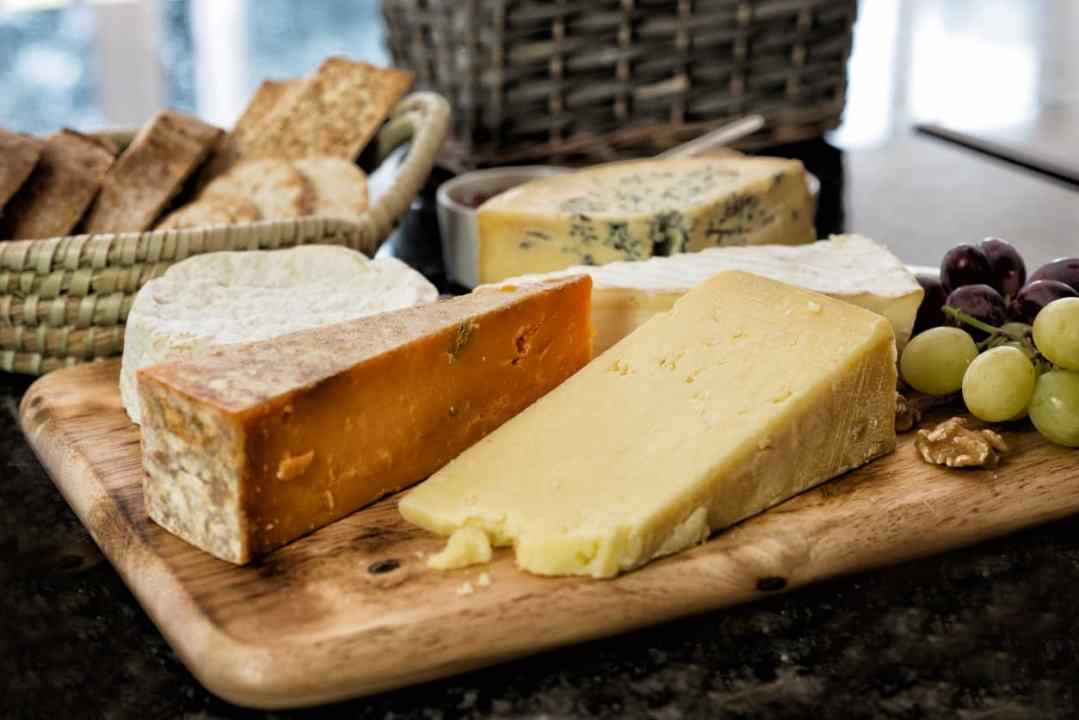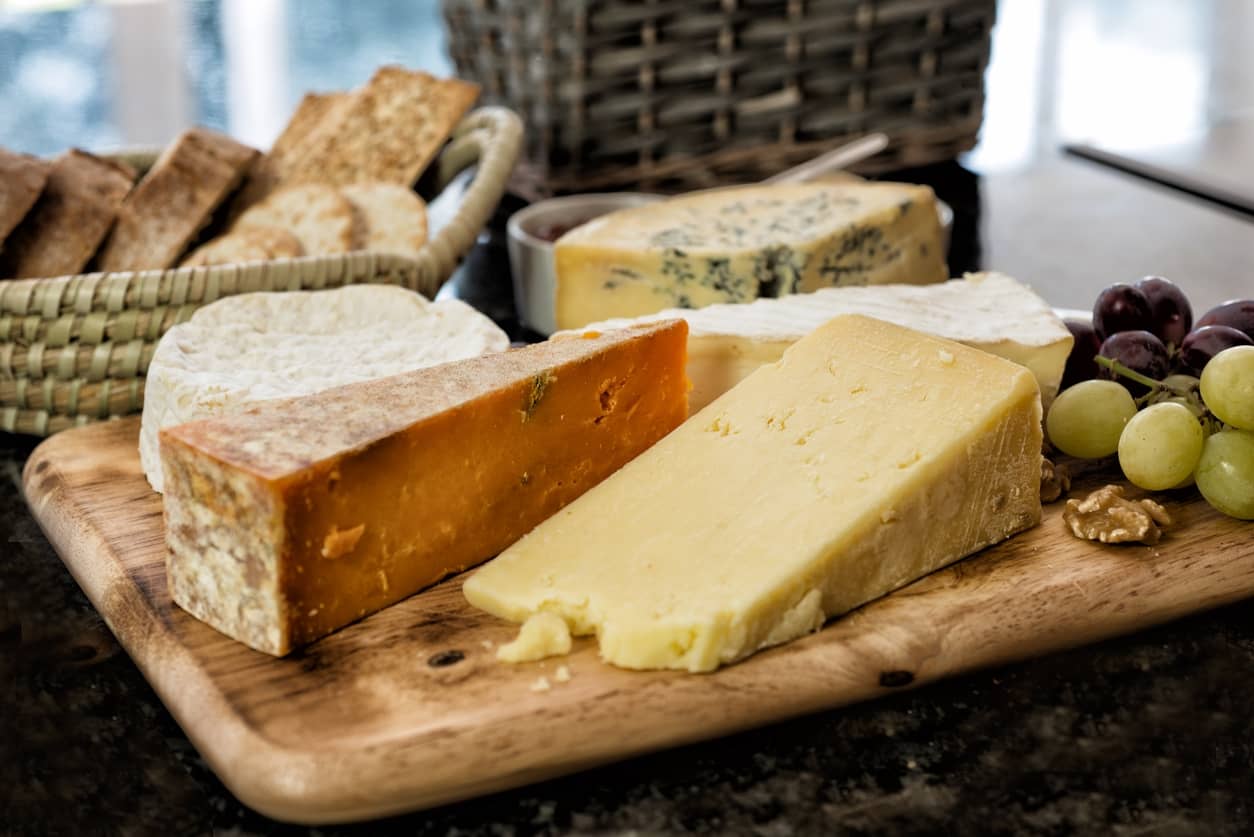The cheeseboard is, arguably, the highlight of any dinner, but there’s an art to crafting a delectable selection. From selecting the right cheeses and serving them at their best to the ensuring a balanced pairing of sundries and sippers, the craft of the cheeseboard is a skill to learn.
It’s time to do away with whipping out a Stilton wheel straight from the fridge. We asked top cheese experts, Hero Hirsh and Sam Wilkin, about the do’s and don’ts of Christmas cheese eating:
How much cheese should you serve?
As a rule, around 100g-150g per person should be plenty, but keep in mind that buying generously ensures your stock will last a few days over the festive period. Sam Wilkin, head cheesemonger at Pick and Cheese, The Cheese Bar and Columbia Road’s Funk, recommends getting fewer but larger wedges, which will last a few days and help the cheese retain its quality.

What is ‘balancing the board’?
‘When you’re building your cheeseboard, it’s important to think about how you lay it out,’ says Wilkin. ‘You want to encourage people to start with those younger, fresher flavours and then work up through the cheeses like they’re changing gear’. That’s why the classic trio of Brie, Cheddar and Stilton works so well – it offers a well-balanced flavour wheel on the cheeseboard.
Don’t forget to consider textures, as well. ‘Start with the light and fluffy and then maybe move towards those oozing and unctuous cheeses before ending with something firmer and crumbly’ Wilkin tells us. ‘On any cheeseboard I build, I always reach for something like the soft Suffolk-made Baron Bigod and follow it with a cloth-bound Cheddar which offers an entirely different experience to a supermarket cheddar’.

For blues, Brits are spoilt for choice. Wilkin’s latest favourite is Pevensey, from artisan producer Martin Tkalez in Sussex. ‘It’s a Gorgonzola-Dolce style cheese – really wonderful. But if you can’t get your hands on it, opt for a classic Cropwell Bishop Stilton. Buttery, smooth, complex, savoury, it’s everything you want from a blue.’
Alternative Sub-Ins
After a tough year in which cheese makers lost much of their restaurant trade, Paxton & Whitfield’s head cheesemonger, Hero Hirsh, sees Christmas as the perfect time to support the cheese industry.
To add some personality to your board, she suggests subbing out big-hitter classics for more unusual British selections. Instead of Cheddar, traditionalists might enjoy a wedge of Lincolnshire Poacher or, for the more adventurous, Irish Mossfield Organic. ‘It’s more of a gouda-style, and it’s such a crowd pleaser,’ Hirsh says. ‘I always say it’s the kind of cheese you can take to parties: not too hard work and very easy to get on with.’

Instead of Stilton, she recommends Lincolnshire’s Cote Hill Blue, a blue brie with a soft consistency and a full flavour. And the French brie? Try a wedge of Baron Bigod instead, or the unctuous Rollright made by Gloucestershire’s David Jowett, which Wilkin holds in high regard. ‘It’s akin to a Vacherin Mont D’Or,’ he tells us. ‘The light, peach rind offers notes of smoky bacon and roasted peanuts, all encasing an incredibly smooth middle.’
Serving your cheese
When it comes to getting your board on the go, you should be getting the cheese out the fridge half an hour before you serve – or an hour if they’re large chunks. When at room temperature, cheese becomes more expressive in flavour. ‘It’s like uncorking a bottle of red an hour before you drink it,’ says Wilkin. ‘You allow it to relax and the flavours to mellow. Straight out the fridge, you aren’t seeing it or tasting it at its best.’
On the board, Hirsh prefers to use larger pieces that look more impressive and provide plenty of leftovers. Avoid spreading the variety too thin – you might be tempted to fill up a slate with seven or eight types of cheese, but you’ll just end up with dinner guests missing out on a few of the wedges.
And for sundries?
Keep your crackers humble, according to the experts. ‘I tend to go very, very simple,’ Hirsh told us. ‘A plain biscuit will let the cheese be the star and that’s important when you’ve spent time selecting cheeses for their flavour.’
Wilkin agrees: ‘For something simple try a Peter’s Yard sourdough. Although, I’m also a sucker for a McVitie’s digestive biscuit paired with blue cheese. That sweetness mixed with the maltiness works well.’

To tip your toes in the more exotic, try matching the strength of the cheese’s flavours. At Paddington’s Cheese Barge Wilkin pairs more unusual combinations to individual cheeses, include green kimchi with Cheddar. ‘Those big, bold pasture-led flavours work well with fermented notes,’ Wilkin says.
Texture, again, is key. ‘I like a bit of crunch,’ Wilkin tells us. ‘Add radishes or celery and a few slices of apple or pear. It’s about a texture contrast: match something with big crunch with a soft, smooth cheese and it’s very satisfying on the palate.’
How should you cut cheese?
If you struggle with stronger flavours, avoid the nose of the cheese (the tip of a wedge) as it’s the centre of a wheel and therefore the cheese’s most mature section. Make sure you provide ample knives, too. A simple mistake many hosts make is not providing enough steel.
‘If one person is cutting the stilton and that same knife is used to cut the goat’s cheese, you’ll completely lose the flavours of the lighter cheese.’ says Wilkin.
What alcohol should you serve with cheese?

‘You want something that complements the cheese, and shares its flavour profile,’ according to Wilkin. ‘Say you’re serving Loire goat’s cheese – all crisp, fresh, lemony minerality. You should be pairing it up with a Sauvignon Blanc which shares the characteristics.’
At the other end the spectrum, for bigger, bolder flavours, the easy choice is marrying port with its comfortable bedfellow stilton. ‘But a chocolate stout works really well with blue cheese – all those sweet, malty coffee notes,’ says Wilkin.
He also advises to avoid bosomy reds. ‘A full-bodied white wine is your best bet across the board. It has the acidity to deal with a goat’s cheese but the body and fruitiness for a lighter blue and full-flavoured hard cheese.’
For a sure-fire pairing, try matching up cheese with a local tipple. ‘My personal favourite for cheese pairing is some of the British cider being produced at the moment,’ says Wilkin. ‘Try pairing clothbound Westcombe Cheddar with Oliver’s The Next Big Thing, a partially keeved cider that’s full of baked apple fruitiness. It has enough tannins to deal with the fat in the cheese, so together offer a refined rusticity.’
What’s on the experts’ cheeseboard this Christmas?

With Covid-19 causing problems across both the British and European cheese industry, both our experts suggest returning to old favourites for a Christmas star. ‘Look for the people who have been doing this for years,’ says Hirsh. Her top pick this year is a Mont d’Or. ‘It’s a seasonal cheese, from the Jura region of France, and it’s at its peak in December. You can peel back the fluffy rind to find a totally liquid inside.’
For Wilkin, the British blues take 2020’s gold. ‘Caws Cenarth make a beautiful smooth and creamy blue called Perl Las. It’s almost malty in flavour.’ He also recommends checking out Young Buck, a Northern Irish raw milk cheese that’s made to the Stilton recipe. The best way to eat it? ‘The guy who makes it has a favourite pairing: atop a chocolate digestive.’






Comments